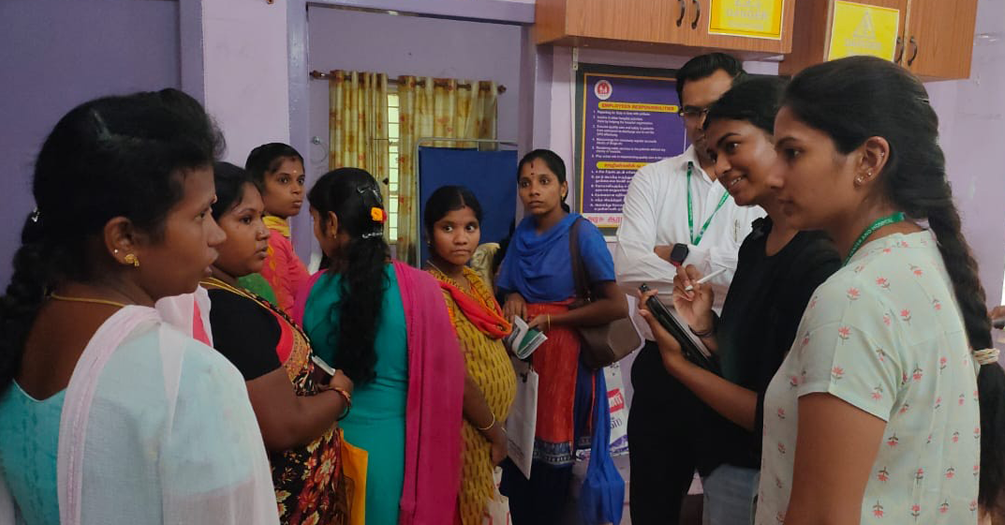A global health internship and connecting to my culture

Sahana Raja
Bachelor’s student in Public Health Sciences
I spent the months of June and July this summer doing an incredible global health internship at the Kovai Medical Center and Hospital (KMCH) in Coimbatore, Tamil Nadu, India. My mother and father were born in Tamil Nadu and immigrated to the U.S. in 1990, so I was familiar with the area itself but not its health.
I initially heard of KMCH through my great aunt. She suggested I contact the Community Medicine department to see if I could do an internship to learn more about public health in India and gain hands-on experience with global health—a topic I was unfamiliar with.
Before I knew it, I was on a plane traveling across the world to live in southeast India for seven weeks. The internship was four weeks, consisting of observations, field visits to rural and primary health centers, discussions with faculty and healthcare workers, patient interactions and self-learning assignments.
I completed 2-3 days each of intensive learning in different public health aspects, such as India’s healthcare delivery systems, biomedical waste management, health economics, health insurance, public health system standards, malnutrition, tuberculosis, water treatment and HIV/AIDS.
Differences in healthcare systems
Health in India is the state’s responsibility. So, in actuality, I was able to gain an in-depth understanding of Tamil Nadu’s healthcare system. Tamil Nadu is a state in South India, known for its unique Hindu temples and large textile industry. It has a mix of private and public healthcare services. The public government hospital systems provide services that are free of cost to individuals who earn below a certain salary.
Tamil Nadu’s healthcare system consists of a hierarchy: sub-centers that are the first contact point between populations and primary healthcare, primary health centers and community health centers. Any health services or advice given in these centers, under India’s National Rural Health Mission (NHRM), are free of cost. I interacted with a range of pregnant mothers at a PHC in a rural village called Mopperipalayam during their antenatal service day (see picture). I talked to them about the services provided and was told that the PHC educated them about pre- and postnatal care of both the mother and child.
One of the biggest surprises I learned was that even though the Indian government spends less than 4% of its GDP on healthcare, it has 65 government schemes, and 14 in Tamil Nadu. A government scheme is a government-sponsored and managed program to improve the standard of living. These schemes mainly cover child and maternal health, but there is at least a scheme for every section of health that is incredible to see. Indian citizens use these government schemes if they earn under a certain level of income dictated by the government.
One scheme, for example, is the Integrated Child Development Services Scheme, which I visited and saw how children were provided nutritional meals, preschool education and primary healthcare.
While health insurance does exist in Tamil Nadu, many people opt for paying out-of-pocket (OOPD). After talking to rural and urban patients in the hospital, the predominant rationale behind this is: “Why should we spend money for my health if I may never get sick? I would rather use my income for food and housing.”
Social determinants of health
Another major difference was observing the social determinants of health (SDOH). After multiple patient interactions, I came to the conclusion that the biggest SDOH were socio-economic status and classism, as well as cultural determinants. There were also factors such as social stigma, where many individuals infected with tuberculosis, for example, would not see a physician due to anxiety about possibly being cast out by society.
Interestingly, the population of Tamil Nadu is 99% ethnically homogeneous; therefore, racism was not as large of a factor when looking at differences in health outcomes as it is in the United States.
Antenatal patient interaction
As part of my internship, I was taken to different wards of the hospital and talked to patients for about half an hour, gathering information on the type of schemes or insurance they have and asking about their SDOH to create a profile. There was one significant patient interaction that will stay with me for the rest of my life:
The woman I talked to was about 25 days from delivery but was in the hospital because she had some difficulty breathing. She is part of a nuclear and joint family with five members and three generations. She does not work, but her husband works in the textile industry and makes an income of 3,000 Rs. (~$36 USD) weekly. Her rent is 3,500 Rs. per month. She said she experienced a lot of financial struggles during the COVID-19 pandemic because there were fewer jobs for her husband and they could not meet the increased standard of living, so they have been struggling financially since the pandemic. I asked her if she was under any government scheme, and she replied that she was under the Chief Minister’s Health Scheme. But that couldn’t be right because, if she was, she wouldn’t have to pay for the services she was receiving and should have been in the government scheme ward for free. I immediately called the nurse and asked her why she was in the private sector of the hospital. The nurse told me they never asked the patient if she was under a scheme and the patient never told her. She was then transferred to the free government ward, which saved her about two weeks’ worth of income. Her mother-in-law thanked me and started crying, saying that it was fate that I met them. This interaction truly touched my heart and reflected the importance of health education on both the hospital and the individual. Unfortunately, this isn’t a rare occurrence, as many people—especially in rural areas—do not know about the schemes they could be under or do not think it is worth the time to fill out the paperwork.
Connecting to my culture
Growing up as a child of Indian immigrants, I had visited India multiple times when I was younger. But this was the first time I lived in and experienced India, its life and culture. Talking to the taxi drivers in the early mornings on the way to the hospital in Tamil, going to the gym and interacting with the trainers, and even having daily conversations with the neighbors all helped me improve my mother tongue language—one of the goals I still hope to get better at.
A higher global calling
The wide spectrum of global health never crossed my mind when I first became interested in public health, as I would often think of health issues in a US context. However, after this internship, I believe that global health can allow for a larger learning of prevention methods and deeper understanding of etiology of both chronic and infectious diseases. For example, India has to deal with mainly communicable diseases, such as malaria and tuberculosis, due to its tropical climate. But in the US, we deal more frequently with many non-communicable diseases, such as cancer and diabetes. I hope that we can learn from both countries’ models to enhance the health of individuals and communities everywhere.
Cover image: Sahana Raja asking pregnant mothers about their determinants of health at a primary healthcare center in the rural village of Mopperipalayam, India.
About the Author
 Sahana Raja is a bachelor’s degree student at the University of Michigan. She is majoring in Public Health Sciences at the School of Public Health and Biopsychology, Cognition, and Neuroscience at the College of Literature, Science and the Arts. She works as a research assistant for the Michigan Neurogenetics and Developmental Psychopathology Lab, as well as the C.S. Mott Children's Hospital National Poll on Children's Health. She is passionate about incorporating health education and medicine to improve health
outcomes, especially among disadvantaged populations.
Sahana Raja is a bachelor’s degree student at the University of Michigan. She is majoring in Public Health Sciences at the School of Public Health and Biopsychology, Cognition, and Neuroscience at the College of Literature, Science and the Arts. She works as a research assistant for the Michigan Neurogenetics and Developmental Psychopathology Lab, as well as the C.S. Mott Children's Hospital National Poll on Children's Health. She is passionate about incorporating health education and medicine to improve health
outcomes, especially among disadvantaged populations.
- Learn more about majoring in public health at Michigan Public Health
- Read: Global health advocate: A journey from Michigan to Thailand
- Read: Exploring public health through a cross-cultural lens
